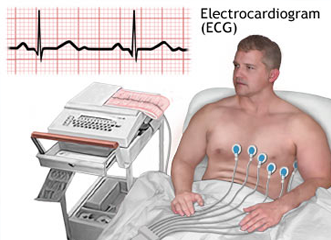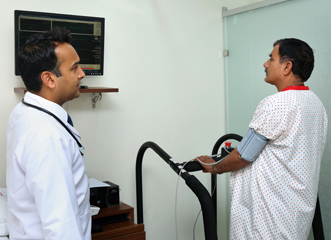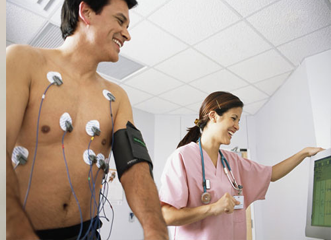Healthy Heart Clinic
The heart is an important organ vital to your survival. Ensure you keep it healthy with our weekly Healthy Heart Clinic. Get a complete examination and consultation with renowned cardiologists along with basic tests included all in one clinic visit.
Echocardiogram
What is the role of ECG?
The role of the ECG is to record the electrical activity or rhythm of the heart. It also checks any abnormal beat, damage or enlargement of the heart muscles.

 Purpose of the test
Purpose of the test
The purpose of the test is to
- Confirm if heart attack has happened
- Predict the risk factor for the heart attack
- Detect changes in heart Rhythm
What exactly happens in an ECG procedure?
ECG is a noninvasive cardiac testing procedure which uses tests outside of the body to record the heart rhythm. The diagnostic test measures the electrical activity of the heart beat. With every beat, an electrical drive (or "wave") goes through the heart.
Because of this wave, the heart muscle crushes and pumps the blood from the heart.
A normal pulse or heart beat on ECG will demonstrate the P wave and T wave shown by upper and lower chambers respectively..
TMT
Treadmill Test (TMT) is also called as Cardiac Stress Test which is used in cardiology to test
Treadmill Test (TMT) is also called as Cardiac Stress Test and used in cardiology to test the ability of the heart to react to outside sources of stress in a controlled medical atmosphere.
The reaction to stress is produced either by exercise or drug stimulation which compares the circulation of blood in the heart when the patient is either resting or he/she is under optimum physical pressure.

 Is TMT procedure a substitute for ECG ?
Is TMT procedure a substitute for ECG ?
For example, in a case like Angina, if the patient is not having any pain in the chest,
the angina symptoms would only come when they increase the heart rate,
while doing some physical exertion like walking. This is a condition where we need a
TMT test and ECG would not be successful as ECGs are taken at rest when the heart is beating at its
lowest rate and patients with a 90% blocks can even have a normal ECG in such a condition.
How is TMT test done?
The TMT test generally takes up to 90 minutes from beginning to end. The major stress test is
only of 20 minutes. The patient’s initial blood pressure is recorded at rest. Next, the
electrodes are placed on the patient’s chest and are connected to the wires that are linked to
the ECG machine.
There is a lead which is placed on different areas of the heart and around 12 lead ECG reports
are recorded on the paper. There are three leads that are connected to the Treadmill monitor
too.
Benefits of TMT or Stress test
Stress tests are quite safe and will help the doctor in diagnosing a heart problem and
determine what and how much of activity is safe for a patient.
Noninvasive Blood Pressure (NIEB)
What is Blood Pressure?
Blood pressure refers to the force of blood pushing against the walls of your arteries. When your heart beats, it contracts and pushes the blood through the arteries to the rest of your body, perfusing all organs. The force generates pressure on the arteries and is known as systolic blood pressure. A normal systolic blood pressure should be less than 120 millimeters of mercury.


‘Diastolic blood pressure’ is the term used to value the bottom number of a blood pressure. This signifies the pressure in the arteries when your heart rests after contracting. A normal diastolic blood pressure is less than 80 millimeters of mercury.
Measuring Blood Pressure
Arterial pressure can be measured invasively or non-invasively. However, the former is restricted to a hospital setting.
Noninvasive Measurement
The noninvasive auscultatory and oscillometric measurements are easier and quicker than invasive measurement, require less expertise in fitting, have no complications, and less painful and unpleasant for the patients. It includes the application of a pressure cuff and can be performed manually or automatically.
Method
Blood pressure is usually determined by analyzing oscillation of BP cuff pressure caused by the arterial pulses.
In order to block arterial blood flow, the BP cuff is inflated and then it starts to deflate. In doing so, arterial pulses generate a pressure wave in the cuff. These waves are the source data for oscillometric noninvasive blood pressure algorithm.
Since the cuff is the sensor, it’s important that the correct size is picked by the clinician. Moreover, the cuff needs to be wrapped around the arm properly.
There are commonly two types of methods for measuring blood pressure:
- An electronic blood pressure monitor generally has an internal pump which inflates the cuff. The inflation of the cuff is monitored electronically from pressure and pulse. The machine gives an indication of blood pressure.
- A mechanical device called sphygmomanometer is also used for measuring blood pressure.
Holter
What is a Holter monitor?
A Holter monitor is a battery-operated portable device which performs traditional test which needs to check the heart rhythm. The device measures and records your heart’s activity (ECG) continuously for 24 to 48 hours.


The device is the size of a small camera and it has wires with silver dollar-sized electrodes which are attached to your skin. The Holter monitor records your ECG as you keep doing your day to day activities and hence is also termed as ambulatory electrocardiograms.
Reason for wearing a Holter monitor
People wear a Holter monitor to let the doctor look at the heart’s activity at one point of the time during
ECG test. When the doctor wants to evaluate your irregular heartbeats called arrhythmias, Holter monitor is the best device to monitor your heart performance carried out during the whole day.
Holter monitor may provide useful information like
- Whether medicines are working optimally or not.
- The device will be able to tell about the conditions such as dizziness, faintness, or the irregular rhythm of the Heart
- Whether the Heart is getting desired oxygen required or not

 9818646277
9818646277




 Purpose of the test
Purpose of the test
 Is TMT procedure a substitute for ECG ?
Is TMT procedure a substitute for ECG ?
 ‘Diastolic blood pressure’ is the term used to value the bottom number of a blood pressure. This signifies the pressure in the arteries when your heart rests after contracting. A normal diastolic blood pressure is less than 80 millimeters of mercury.
‘Diastolic blood pressure’ is the term used to value the bottom number of a blood pressure. This signifies the pressure in the arteries when your heart rests after contracting. A normal diastolic blood pressure is less than 80 millimeters of mercury.
 The device is the size of a small camera and it has wires with silver dollar-sized electrodes which are attached to your skin. The Holter monitor records your ECG as you keep doing your day to day activities and hence is also termed as ambulatory electrocardiograms.
The device is the size of a small camera and it has wires with silver dollar-sized electrodes which are attached to your skin. The Holter monitor records your ECG as you keep doing your day to day activities and hence is also termed as ambulatory electrocardiograms.
Follow Us On: